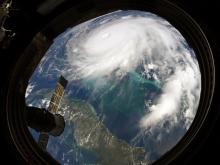- Mosquito activity on the rise due to rainfall, flooding across Texas
- Volunteers help Conroe community clean up in wake of flooding in Montgomery County
- Why leaders are urging NC residents to start hurricane prep now
- Storms could produce hail, damaging winds south of Charlotte
- Large hail and strong winds cause damage in San Marcos and the Hill Country
'Like zombies': Hurricane victims face up to the disaster

ABACO, Bahamas — Lugging empty suitcases, plastic buckets and backpacks, dazed survivors of Hurricane Dorian made their way back to the shantytown where they used to live, hoping to gather up some of their soggy belongings.
The community was known as The Mudd, and it was built by thousands of Haitian migrants over decades. It was razed in a matter of hours by Dorian, which ripped apart the shelters and scattered splintered plywood and two-by-fours for miles.
A helicopter buzzed overhead Thursday as people picked through the debris, avoiding a body that lay tangled underneath a tree branch next to twisted sheets of corrugated metal, its hands stretched toward the sky. It was one of at least nine bodies that people said they had seen in the area.
“Ain’t nobody come to get them,” said Cardot Ked, a 43-year-old carpenter from Haiti who has lived 25 years in Abaco. “If we could get to the next island, that’s the best thing we can do.”
Ked was one of thousands of desperate people seeking help in Dorian’s aftermath. With winds of 185 mph (295 kph), the hurricane obliterated houses on the Bahamas’ Abaco and Grand Bahama islands, home to some 70,000 people, triggering a huge search-and-rescue operation and an international humanitarian effort to bring food, water and medicine to victims.
The official death toll from the government stood at 20 and was certain to climb.
Total property losses, not including infrastructure and autos, could reach $7 billion, the firm Karen Clark & Co. estimated.
One of the dead was the sister-in-law of Benatace Pierre-Louis, 57, who collects and sells scrap metal. He said she died in The Mudd after she got hit by plywood as she tried to escape the storm.
“They gone, but we can’t do nothing,” he said, adding that Bahamian immigration officials had visited The Mudd ahead of Dorian and told people to go to shelters.
Abaco and Grand Bahama islands are known for their marinas, golf courses and all-inclusive resorts and are home to many fishermen, laborers and hotel workers. The dirt-path shantytown is locally known as Da Mudd.
Elsewhere across the Bahamas, the injured included 89-year-old Sylvia Cottis, who uses a wheelchair. She had a gash on her right knee, along with infected wounds in her calf from shards of glass from a blown-out window.
Before she was rescued Wednesday, Cottis had spent days sitting in her wheelchair and the nights sleeping in a metal lawn lounger surrounded by wet belongings and sewage after the septic tank overflowed with floodwaters.
Among those who lost their homes was Samson Kersint, a 38-year-old who worked in a lumberyard and has been in the Bahamas since 1998.
“We walking like zombies,” he said as he walked around The Mudd with a backpack. “We ain’t find no one to talk to us. Ain’t no water, no light.”
People from The Mudd and other storm victims were given temporary shelter at a nearby hospital and government center.
Among those who looked for anything salvageable at the The Mudd was Ilphody Norvilus, a 37-year-old painter. He clutched a big white plastic bucket as he picked up rubber sandals, white plastic plates and a big purse.
“I lost everything,” he said. “I don’t know what I’m going to do. I don’t have a house to live in.”

